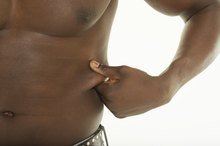How Many Crunches Should You Do to Lose Belly Fat?
Even if you did 1,000 crunches every day, you'd unlikely trim the fat around your belly. That's because crunches tone the muscles that lie underneath your fat, but they do very little to help you lose weight -- which is the key to shrinking your belly. Instead of focusing on doing multiple crunches, emphasize a healthy diet and a well-rounded workout routine that includes cardio, weight training and functional abdominal exercises for improved posture and tone. You can even get away with zero crunches and still get a flatter belly.
Belly Fat Reduction
To control abdominal fat, you need to participate in regular exercise, according to the experts at Harvard Health Publications. A study published in a 2007 issue of the "Journal of Physiology" determined that people who did cardio exercise equivalent to jogging 20 miles per week significantly reduced belly fat after eight months. This is equal to about 50 minutes per day of high-intensity exercise four to five times per week, which surpasses the Centers for Disease Control and Prevention recommendations to exercise 150 minutes per day at a moderate intensity. A later study published in a 2008 issue of "Medicine and Science in Sports and Exercise" confirmed that high-intensity exercise was more effective than low-intensity exercise in trimming belly fat. Crunches are not a cardio exercise, like swimming, cycling, kickboxing or jogging, and they do not raise your heart rate for a sustained period of time to burn calories and challenge your cardiovascular fitness.
Diet
Abdominal Compression for Weight Loss
Learn More
Including more cardio activity, even without changes in your diet, can help you reduce belly fat. Making changes to your eating habits, however, can expedite your results. Losing weight all over means your belly fat will shrink. To lose weight, you need to eat fewer calories than you burn. A 500-calorie deficit per day can lead to a pound of weight loss per week. To create this deficit, trim portion sizes and choose low-calorie, nutrient-dense foods. For example, opt for fruits, vegetables and whole grains over white bread, refined-grain baked goods and pasta and sugary treats. Go for moderate portions of unsaturated fats and lean proteins. Watch your calorie intake, but don't starve yourself, warn Harvard researchers, or risk slowing your metabolism and storing more fat.
Fitting in Crunches
Crunches can be part of a total-body strength-training regimen that may help you diminish or prevent the regain of belly fat. A study published in the "American Journal of Clinical Nutrition" in 2007 determined that women who participated in total-body resistance training two times per week were able to keep their fat gain down over the course of two years, including at their belly. Crunches address your abdominal muscles, but you also need to do exercises to hit the other major muscle groups including the legs, hips, shoulders, chest, back and arms. At least one set of eight to 12 repetitions of exercises for all of these muscle groups -- including crunches -- completes a total body routine.
More Effective Abdominal Exercises
How to Reduce Your Waist Size Without Weight Loss
Learn More
Although they don't burn fat, abdominal exercises do offer postural, athletic, functional and toning benefits. When you do lose weight, regular strength training for your core will reveal a taut and lean middle. Crunches do target the rectus abdominis, the front sheath of the abdominal wall, and the obliques at the sides of your waist, but not as effectively as other exercise. A study commissioned by the American Council on Exercise in 2001 determined that moves such as the bicycle crunch, in which you lie on the floor with your legs elevated and bring opposite shoulder to opposite knee, and the captain's chair, an apparatus that looks like a high, seatless chair, are more than 200 percent more effective in targeting both of these abdominal muscle groups. Many mat Pilates classes are also far more effective than the classic crunch in terms of targeting the rectus abdominis and the obliques, reported a November 2005 study from the IDEA Health and Fitness Association. You should also choose stabilization exercises that address the transverse abdominis deep within your core. Plank holds and anti-rotation exercises are examples of stabilization moves.
Related Articles
References
- Harvard Health Publications: Abdominal Fat and What to Do About It
- Journal of Applied Physiology: Inactivity, Exercise and Visceral Fat
- Medicine and Science in Sports and Exercise: Effect of Exercise Training Intensity on Abdominal Visceral Fat and Body Composition
- American Journal of Clinical Nutrition: Strength Training and Adiposity in Premenopausal Women
- IDEA Health and Fitness Association: Pilates Exercise: Lessons from the Lab
- American Council on Exercise: Putting the Crunch on Ineffective Abs Exercises
Writer Bio
Andrea Cespedes is a professionally trained chef who has focused studies in nutrition. With more than 20 years of experience in the fitness industry, she coaches cycling and running and teaches Pilates and yoga. She is an American Council on Exercise-certified personal trainer, RYT-200 and has degrees from Princeton and Columbia University.








